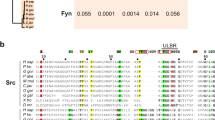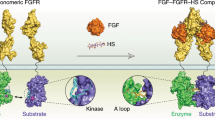Abstract
The activity of the c-Src tyrosine kinase is regulated through intramolecular interactions between the catalytic and SH2/SH3 domains. However, the exact mechanism by which this occurs remains obscure. In the crystal structure of c-Src, the peptide that links the SH2 and catalytic domain (SH2-CD linker) is sandwiched between the latter and the SH3 domain. A residue in the linker, Leu 255, inserts its side chain into a deep hydrophobic pocket present on the surface of the catalytic domain. To investigate the possible regulatory role of this prominent interaction, we mutated Leu 255 to different hydrophobic residues. We found that the length and 'bulkiness' of the side chain had a profound influence on c-Src regulation. Src-L255V was highly active but showed reduced SH3 accessibility in vitro as well as an altered localization in vivo when compared to other deregulated forms of Src. Our analyses lead us to suggest that the Leu 255–pocket interaction is a critical component of the intramolecular inhibition mechanism of Src family kinases.
This is a preview of subscription content, access via your institution
Access options
Subscribe to this journal
Receive 12 print issues and online access
$189.00 per year
only $15.75 per issue
Buy this article
- Purchase on Springer Link
- Instant access to full article PDF
Prices may be subject to local taxes which are calculated during checkout





Similar content being viewed by others
References
Hubbard, S.R., Mohammadi, M. & Schlessinger, J. J. Biol. Chem. 273, 11987– 11990 (1998).
Bishop, J.M. Genes Dev. 9, 1309–1315 (1995).
Brown, M.T. & Cooper, J.A. Biochim. Biophys. Acta 1287, 121–149 (1996).
Xu, W., Harrison, S.C. & Eck, M.J. Nature 385, 595– 602 (1997).
Sicheri, F., Moarefi, I. & Kuriyan, J. Nature 385, 602– 609 (1997).
Williams, J.C. et al. J. Mol. Biol. 274, 757– 775 (1997).
Williams, J.C., Wierenga, R.K. & Saraste, M. Trends Biochem. Sci. 23, 179– 84 (1998).
Moarefi, I., et al. Nature 385, 650–653 (1997).
Alexandropoulos, K. & Baltimore, D. Genes Dev. 10, 1341–1355 (1996).
Briggs, S.D., Sharkey, M., Stevenson, M. & Smithgall, T.E. J. Biol. Chem. 272, 17899–17902 (1997).
Gonfloni, S. et al. EMBO J. 16, 7261–7271 (1997).
LaFevre-Bernt, M., et al. J. Biol. Chem. 273, 32129– 32134 (1998).
Sicheri, F. & Kuriyan, J. Curr. Opin. Struct. Biol. 7, 777–785 (1997).
Yamaguchi, H. & Hendrickson, W.A. Nature 384, 484–489 (1996).
Superti-Furga, G., Fumagalli, S., Koegl, M., Courtneidge, S.A. & Draetta, G. EMBO J. 12, 2625– 2634 (1993).
Glenney, J.R. & Zokas, L. J. Cell Biol. 108, 2401–2408 (1989).
Kaplan, K.B. et al. EMBO J. 13, 4745–4756 (1994).
Rohrschneider, L. & Rosok, M.J. Mol.Cell. Biol. 3, 731–746 ( 1983).
Xu, W. et al. Mol. Cell 3, 629–638 (1999).
Schindler, T. et al. Mol. Cell 3, 639–648 (1999).
Ausubel, F.M., et al. In Current protocols in molecular biology. (Wiley, New York; 1987).
Lipsich, L.A., Lewis, A.J. & Brugge, J.S. J. Virol. 48, 352– 360 (1983).
Nicholls, A., Sharp, K.A. & Honig, B. Proteins 11, 281– 296 (1991).
Acknowledgements
We would like to thank J. Williams and R. Wierenga for helping us appreciate the importance of the hydrophobic pocket, A. Nelsbach and his colleagues at New England Biolabs for the very valuable anti-phospho-Y416 antibodies, E. Conti, M. Bottomley and Y. Modis for help with GRASP, R. Salgia and J. Griffin for paxillin cDNA, W. Pluk for the HA-paxillin construct, G. Cesareni for suggestions, E. Conti, A. Nebreda and members of the laboratory for critical reading of the manuscript. S.G. was supported by a fellowship from the Boncompagni-Ludovisi Foundation and F.F. is a recipient of an EMBL predoctoral fellowship.
Author information
Authors and Affiliations
Corresponding author
Rights and permissions
About this article
Cite this article
Gonfloni, S., Frischknecht, F., Way, M. et al. Leucine 255 of Src couples intramolecular interactions to inhibition of catalysis. Nat Struct Mol Biol 6, 760–764 (1999). https://doi.org/10.1038/11537
Received:
Accepted:
Issue Date:
DOI: https://doi.org/10.1038/11537
This article is cited by
-
AC-93253 iodide, a novel Src inhibitor, suppresses NSCLC progression by modulating multiple Src-related signaling pathways
Journal of Hematology & Oncology (2017)
-
A switch in nucleotide affinity governs activation of the Src and Tec family kinases
Scientific Reports (2017)
-
HLJ1 is an endogenous Src inhibitor suppressing cancer progression through dual mechanisms
Oncogene (2016)
-
Construction of a linker library with widely controllable flexibility for fusion protein design
Applied Microbiology and Biotechnology (2016)
-
Active site profiling reveals coupling between domains in SRC-family kinases
Nature Chemical Biology (2013)



